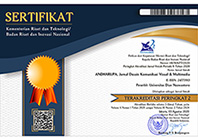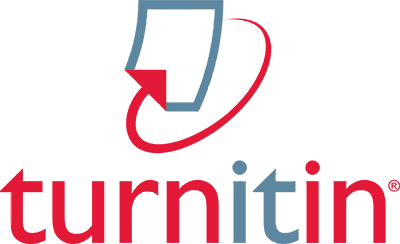Dampak Model Pembelajaran Produksi Film Pendek tentang Energi Terbarukan pada Mata Kuliah Audio Visual terhadap Mahasiswa
Abstract
Â
Abstrak
Penelitian ini menguji dampak desain dan pengembangan produksi film pendek renewable energy terhadap pengetahuan, minat dan atensi atau kepedulian mahasiswa terhadap renewable energy. Model pembelajaran, yaitu produksi film pendek, dikembangkan dengan fitur-fitur utama dari pelajaran video dan fitur lain dalam mendukung proses belajar mahasiswa. Beberapa film pendek menggambarkan proses produksi biodiesel atau energi terbarukan, yang merupakan salah satu permasalahan krusial saat ini tentang berkurangnya energi fosil yang harus segera diatasi. Mahasiswa sebagai generasi muda penerus bangsa kurang peduli terhadap permasalahan ini, sehingga perlu adanya model pembelajaran tentang energi terbarukan yang dapat meningkatkan pengetahuan, minat dan kepedulian mahasiswa terhadap berkurangnya energi fosil saat ini. Salah satu model pembelajaran alternatif untuk memperjelas subyek ini adalah melalui produksi film pendek bertema renewable energy di kelas Audio Visual. Metode penelitian yang digunakan adalah metode deskriptif kualitatif dan metode kuantitatif. Responden dalam penelitian ini sebanyak 64 mahasiswa dari kelompok mata kuliah Audio Visual. Model Pembelajaran sepenuhnya menggunakan film pendek. Evaluasi dampak dari model pembelajaran ini menunjukkan bahwa ternyata dengan model pembelajaran ini pengetahuan, minat dan atensi atau kepedulian mahasiswa meningkat setelah memproduksi film pendek dengan tema renewable energy.
Â
Kata kunci: film pendek, renewable energy, model pembelajaran, dampak pembelajaran
Â
Abstract
This study examines the impact of design and development short film production themed Renewable energy towards students’ knowledge, interests and attention to renewable energy. The learning model, namely short film production was developed with the main features of video lessons and other features in supporting student learning. Some short films describe the process of biodiesel production or renewable energy, which is one of the crucial problems at present about the reduction in fossil energy, which should be addressed immediately. Students as the nation's next generation of young people did not care about this problem, so there needs to be a learning model of renewable energy that can increase students' knowledge, interest and attention for the current reduction of fossil energy. One of learning model to clarify this subject is through the production of Short Film with the theme of Renewable energy in the Audio Visual class. The research method used is descriptive qualitative and quantitative methods. Respondents in this study were 64 students from Audio Visual courses. The learning model fully uses short films. The evaluation of this learning model, which shows that it turns out that with this learning model knowledge, interest and attention or concern of students increased after producing a short film with the theme Renewable energy.
Keywords: short film, renewable energy, learning model, impact of learning
Full Text:
PDFReferences
Amatller, A.M., and Simó, L. P. 2007. Audiovisual and Multimedia Resources in e-Learning. First Video Funet Conference, 10â€11 May. Tampere, Finland.
Balanskat, A., and Roger, B., and Stella K .2007. The ICT Impact Report. http://insight.eun.org/ww/en/pub/insight/misc/specialreports/impact_study.htm. Accessed 10th July 2008. De Porter, B., and Mike H. (2007). Quantum Learning. Bandung : Kaifa.
De Porter, B., and Mike H. 2007. Quantum Learning. Bandung : Kaifa.
Effendy, Heru. 2010. Mari Membuat Film. Edisi 2. Jakarta: Erlangga.
Eisner, E. 1994. Cognition and curriculum reconsidered. 2nd ed. New York: Teachers College Press.
Gardner, H. 1993. Multiple intelligences: The theory in practice. New York: Basic.
How, G. K. 2000. Journal of Education TIGAENF 1999/2000 (in Indonesian), pp. 57- 63.
Kasper, L. F. 2000. The imagery of rhetoric: Film and academic writing in the discipline-based ESL course. Teaching English in the Two-Year College, 28(1)
Luen, K.W., Fook, S.O. and Yong, T.K. 2012. Constructing a survey questionnaire to collect data on service quality of business academics. European Journal of Social Sciences. Vol. 29, No. 2. pp. 209-221.
Ossai-Ughbah N.B., and Ogunrombi S.A., and Ameh I.O. 2012. Motivating use of Audio-Visuals in a Nigerian Technological University Library. Journal of Educational and Social Research. Vol. 2, No.1. p. 217233.
Perdana, S.C. 2008. The Method of Learning VCD Usage (in Indonesian). http://vcdpembelajaran.com. Accessed 12th Sept 2008.
Prinou, L., Halkia, K. 2003. Images Of ‘Cell Division’ On The Internet. http://cblis.uniza.sk/cblis-cdold/2003/4.PartC/Papers/Visualization_of_ science_ideas/Prinou.pdf. Accessed 10th Dec 2009.
Prokop, P. 2007. Slovakian students’ attitudes towards Biology. Eurasia Journal of Mathematics, Science & Technology Education, Vol. 3, No. 4.
Richard, P.V., and Teresa, A.S. 2000. Computer technology in the College of Agriculture classroom at Lousiana State University. Journal of Campus-Wide Information Systems, Vol. 17, pp. 81-85.
Romero, N.L., and Centellas, F.C. 2008. New stages, new narrative forms: The Web 2.0 and audiovisual language [on line], Number 6, May 2008, http://www.hipertext.net/english/pag1030.htm. Accessed 12th Sept 2008.
Saputro, G. E., Haryadi, T., & Yanuarsari, D. H. 2016. Perancangan
Purwarupa Komik Interaktif Safety Riding Berkonsep Digital Storytelling. ANDHARUPA: Jurnal Desain Komunikasi Visual & Multimedia, 2(02), 195–206.
Sudjana, N., and Ahmad, R. 2005. The Teaching Media (in Indonesian). Bandung: Sinar Baru Algensindo.
Sugiyono. 2012. Metode Penelitian Pendidikan Pendekatan Kuantitatif, Kualitatif, dan R & D. Bandung: Alfabeta.
Suleman, Q., Aslam, H.D., Sarwar, S., Shakir, M.M.N., Hussain, I. 2011. Effectiveness of Educational Technology in Teaching Chemistry to Secondary School Students in Khyber Pukhtunkhwa (Pakistan). American Journal of Scientific Research. Issue 41. 2011, pp. 115-131. Euro Journals Publishing, Inc 2011.
Tekkaya, C., Ozkan, O., Sungur, S. 2001. Biology Concepts Perceived as Difficult by Turkish High School Students. Hacettepe Universitesi Egitim Fakultesi Dergisi ed. 21, pp. 145-150.
Thomson, J. & Volker, J. 1996. Australians Visual Art: Libraries and the New Technologies. Inspel 30, pp. 237 – 244.
Tongco, M.D.C. 2007. Purposive sampling as a tool for informant selection. Ethnobotany Research & Applications Journal. Vol 5. pp. 147 – 158.
www.utahbio.com
DOI: https://doi.org/10.33633/andharupa.v4i02.1979
Article Metrics
Abstract view : 643 timesPDF - 503 times
Refbacks
- There are currently no refbacks.
indexed by:
Andharupa Journal (p-ISSN: 2477 - 2852 | e-ISSN: 2477 - 3913) is published by Dian Nuswantoro University, Semarang. This Journal is licensed under Creative Commons Attribution 4.0 International License.
























